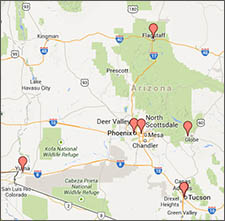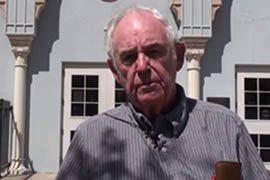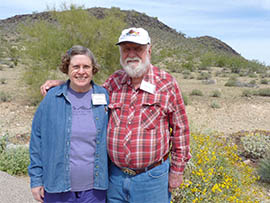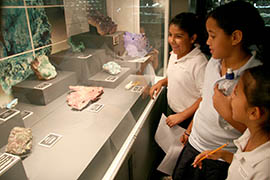Cronkite News has moved to a new home at cronkitenews.azpbs.org. Use this site to search archives from 2011 to May 2015. You can search the new site for current stories.
Years later, not much to show for state Mining and Mineral Museum’s closure
PHOENIX – For Sandra Sawyer, the Arizona Mining and Mineral Museum was seeing her son’s eyes widen before a large purple amethyst.
“There were so many beautiful things,” she said. “We loved it.”
For Marco Hernandez, a fifth-grader at East Valley Academy, the museum was starting his own rock collection as a first-grader when he pulled tungsten and halite from a rusty mining cart in the gift shop.
“It was an awesome experience to have a field trip in the mining and mineral museum,” he said.
And for Shirley Cote, a former volunteer and part-time employee, the museum was teaching the world about the science of minerals and the importance of mining to modern civilization. She recalls her time there with tears in her eyes.
“It was our life. We just loved the place,” she said. “It just felt like we were doing something for the betterment of society.”
The Arizona Mining and Mineral Museum left a collection of memories in the minds of its visitors, volunteers and staff after it closed in 2011 to make way for a centennial-themed museum that never got funded.
Hundreds of specimens from private collections once on display are back with their owners, and the state’s mineral collection of more than 20,000 specimens has spread to museums across the state.
The museum’s moon rock, 200-pound meteorite and 8-foot-long hunk of copper can no longer be viewed by the schoolchildren who once flocked to the museum – more than 25,000 of them in fiscal 2010.
The doors on 1502 W. Washington St. remain locked, though a 12-foot-tall mining truck tire and a 19th century stamp mill for crushing gold in front of the building still appear to beckon visitors inside.
And three years later, passionate individuals still remember the museum, still feel frustrated with the state for closing it and still wish there was a way to bring it back.
One of them is Janet Stoppleman, a teacher at East Valley Academy in Mesa who said the museum represented Arizona’s heritage as a state built upon copper mining and the Grand Canyon’s appeal to tourists.
“In a state that has all of these geologic wonders, it just doesn’t make any sense to me,” Stoppleman said. “And it’s not fair to the taxpayers and their children because that is a legacy that they deserve to have as Arizonans.”
Origins and end
The Arizona Mining and Mineral Museum started as a mineral exhibit at the Territorial Fair in 1884, and it was so popular that the state Legislature allocated funding for the exhibit to gain its own building at the state fairgrounds in 1917.
Seventy years later, the building on the fairgrounds had become dilapidated, moldy and prone to floods. So in the early 1990s Gov. Rose Mofford and Rep. Polly Rosenbaum, who had both lived in the mining city of Globe, pushed successfully for the state to purchase what had been the El Zaribah Shrine Auditorium and give the old museum a new home.
“We packed all the minerals up, put them in boxes and carted them all over to the new building,” said Doug Duffy, who worked part-time there with his wife, Shirley Cote, for more than 20 years. “We repainted all the cases, fixed everything up and got everything started again.”
But by February 2010, a new fate had been set for the museum. Gov. Jan Brewer gave a speech there to announce that it would become the Arizona Centennial Museum, describing it as her birthday gift to Arizona.
“This new Centennial Museum will be a vibrant, interactive facility, offering state-of-the-art technology and exhibits unlike any in Arizona,” she said in a news release.
Plans for the new museum called for renovations to the building and centered on Arizona’s Five C’s: copper, cattle, climate, citrus and cotton.
“This facility will feature educational profiles of each industry, showcasing the rich heritage of Arizona’s economy and providing a vision of its brilliant future,” Brewer said in the release.
But these plans foundered during the Great Recession when the Arizona Centennial Commission, tasked with funding the building through private donations from industries in the Five C’s, couldn’t raise the money.
Karen Churchard, former director of the Centennial Commission and assistant deputy director at the Arizona Office of Tourism, said the commission started fundraising for the museum in fall 2010. But over the course of two years it could only raise $1.75 million from the copper company Freeport McMoran and various private donors, Churchard said.
State government put any money from the budget toward the project because it was in the midst of its own financial crisis, Churchard said.
“It was the recession. So we hit the wall and really were not able to successfully raise the money, which is unfortunate, but that’s just the way the reality was,” Churchard said.
With a goal of opening sometime in 2012 as a part of the state’s centennial celebration, the total cost for these changes was initially estimated at $10 million, Churchard said.
Over time, as fundraising lagged, the name for the museum changed to the Arizona Experience Museum because various meetings with stakeholders indicated an interest less in Arizona’s history and more in a vision of Arizona’s past, present and future with the Five C industries, Churchard said.
“It morphed into becoming this Arizona experience so that it wouldn’t be just about how the Five C’s shaped our state going backwards in time but how those Five C’s are still sustainable today,” Churchard said.
As the concept evolved, the budget for the museum rose to $12.75 million and eventually $15 million.
“The actual product itself was amazing. It would have been fabulous for our state to have this,” Churchard said.
Who’s in charge?
A bill introduced by former Rep. Russ Jones, R-Yuma, in April 2010 after Brewer’s announcement transferred responsibility for planning and management of the new museum from the Department of Mines and Mineral Resources to the Arizona Historical Society.
“Given the mining museum is a museum and the historical society, in fact, is in the business of running museums, it seemed like the most likely fit for a good home,” Jones said at a hearing for the bill with the Senate Committee on Natural Resources, Infrastructure and Public Debt.
In a January telephone interview, Jones said handing oversight for the state’s collection over to the historical society relieved budget pressures for the Department of Mines and Mineral Resources.
“The only way to preserve as much as could of it was to have the building taken over by the state historical society and run through their budget,” Jones said.
A year after Brewer signed the bill that moved oversight for the museum to the Arizona Historical Society, she signed another that absorbed the Department of Mines and Mineral Resources into the Arizona Geological Survey.
Only 44 percent of the $858,200 budget for the Department of Mines and Mineral Resources actually went to running the agency in fiscal 2010. The other 56 percent of the agency’s budget – $480,400 – went to the Arizona Department of Administration as rent for the museum space, according to the Joint Legislative Budget Committee.
Rent was actually a fee calculated by the Arizona Department of Administration based on maintenance and security of state-owned buildings, Jeff Grant, deputy director of the department, said in an email.
Paying that building fee made the department financially unviable, according to a 2010 statement from Museum Director Madan Singh in Board of Governors meeting minutes for the Department of Mines and Mineral Resources.
Jan Rasmussen, former curator for the museum, said she doesn’t understand how moving the museum to the Arizona Historical Society saved the state any money. In her view, the same rent line just got moved to another department.
“That was a very feeble justification. In other words, all of the rent and the salary for the curator still went to the historical society. So there was no change,” she said.
According to a report by the Joint Legislative Budget Committee, the fiscal 2014 budget provides $428,000 to the Arizona Historical Society, $360,800 of it for rent on the unused museum space and $67,500 for a curator to care for the state’s mineral specimens.
Former Sen. Sylvia Allen, R-Snowflake, helped draft the bill that established the Centennial Museum but now she said she regrets her role in the old museum’s closure.
“Something that I think was working very well and really of a value to the state is gone, and I feel sad about that,” Allen said. “In retrospect I wish we could have kept it intact and figured out something else to do with the money.”
A Joint Legislative Budget Committee report for the Department of Mines and Mineral Resources showed that the museum was rated 4.9 out of 5 on a customer satisfaction scale in fiscal 2010.
When the Department of Mines and Mineral Resources was audited in 2005 by the House of Representatives Natural Resources, it was praised for running the museum efficiently on a small budget.
“Consolidating the Museum with another agency would dilute or eliminate the fundamental message that the museum delivers so well – that mining is necessary for civilization, that it is done in an environmentally responsible manner, and that the United States is dependent on Arizona’s remarkable mineral deposits,” it read.
Brewer’s press office didn’t respond to multiple requests for comment on the closure of the Arizona Mining and Mineral Museum and the failure to open a museum in its place.
Though a project description for the Arizona Experience Museum stated that the Arizona Mining and Mineral Museum was scheduled to close June 1, 2011, the Arizona Historical Society closed the building early on May 1, 2011.
The following Monday, a school bus full of children arrived at the museum to find locked doors, said Duffy, the former part-time employee.
“The thing about kids and field trips is they don’t get very many field trips any more. The schools can’t afford the buses,” he said. “So when they waste one like that, that’s pretty sad.”
The minerals
Susan Celestian, a former curator of the museum who worked there for 12 years until 2007, said the state’s rock collection was never appraised for monetary value. But the specimens themselves were priceless for their educational and historic value, she said.
“It was a broad spectrum of nice specimens from around the state that we were able to put in perspective for people,” she said. “These were what mines in Arizona have produced and why mining is important to Arizona. You can’t dig this stuff anywhere; you have to go where it is.”
Of the more than 20,000 specimens in the collection, about 3,500 of them were displayed at the old museum while the rest were stored there.
Until about a month ago, the public could view a portion of the collection, including the moon rock and an 8-foot-tall copper piece, at the University of Arizona Mineral Museum, said Mark Candee, the UA museum’s assistant curator and collection manager.
But those specimens have been moved to Tempe in preparation for the opening of the Arizona Historical Society’s planned Gallery of Natural History at the Museum at Papago Park, Candee said.
In a February phone interview, Madison Barkley, the Arizona Historical Society’s curator for the natural history collection, said the gallery would open sometime in late spring and display about 1,000 specimens. She said in the meantime she’s completing an inventory of the mineral collection that updates the condition and value of each specimen.
Outside of exhibiting the core collection in Tempe, Barkley said the Arizona Historical Society aims to have specimens from the collection on display in its museums across the state. Those additional locations include the Arizona History Museum in Tucson and temporary locations for museums in Yuma and Flagstaff, she said.
“The goal was always to kind of have mineral exhibits everywhere in all our museums,” Barkley said.
Susan Celestian, the former curator, said she worries about the collection’s safety.
“People don’t know how to handle minerals, and if they rearrange the case or, you know, clean a case or something, things get damaged,” Celestian said. “They have one person on staff, and I just worry that the collection will just sort of be dribbled out to various little museums and kind of be lost.”
Private collections
Besides the state’s collection, the Arizona Mining and Mineral Museum also used to house the Flagg Mineral Collection, named after Arthur Flagg, the museum’s first curator.
Over the years the Flagg collection amassed a trove of top-quality, world-class specimens, some of them valued at more than $100,000, said Bob Jones, the last surviving founder of the foundation.
About 250 of the 700 pieces in the collection are on display at the UA Mineral Museum, according to the Flagg Mineral Foundation website. In the old museum, there was room to display all of the specimens, Jones said.
The old museum also featured the Rose Mofford Gallery, which displayed more than 1,000 historical items from the collection of former Gov. Rose Mofford, including kachina dolls and Native American artwork. Those have been moved to the Bullion Plaza Cultural Center and Museum in Miami.
“This fantastic exhibit was my pride and joy. Thankfully, I was able to rescue many of its exhibits and move them to Globe and Miami, where they are properly cared for,” Mofford said in a 2013 Arizona Republic guest column. “But how sad that these historical riches are no longer readily available in our state’s capital.”
Outside the old museum is a collection of weathered mining equipment: one of Arizona’s first steam locomotives, a 19th century stamp mill for refining gold, a 12-foot-diameter mining truck tire, a 12-foot-tall dipper for shoveling open pit mines and a 1920s headframe structure originally placed over mines near Bisbee.
The future of this equipment remains uncertain.
Charlie Connell volunteered at the museum for almost two decades and coordinated the transfer of most of the equipment from various mining companies to the museum.
“The worst thing that could happen would be if they came and just basically took it all apart and stuck it in a warehouse,” Connell said.
What’s next?
The El Zaribah Shrine Auditorium, which opened in 1921, hosted gatherings for members of the Arizona chapter of Shriners International. Now former Phoenix Mayor John Driggs wants to reopen the facility as a place for discussing civic issues.
Driggs is working with Ryden Architects and MRT Design to update six buildings in the Phoenix area, including the old State Capitol, that he said haven’t reached their potential, a project called “A Plan to Encourage Public-Private Partnerships for Building Harmony by Revitalizing Public Architectural Landmarks.”
Proponents want to focus on the old Arizona Mining and Mineral Museum first because it’s currently not being used, said Don Ryden, historical architect for the project.
“We walked in late in the game and we saw it as an opportunity that complemented our idea for civic action at the Capitol building,” Ryden said.
The plan is to have the building serve as a space for civic engagement with state agencies, local associations, school boards, nonprofits, councils, tribes and other groups that could rent out the facility or certain rooms in it, Ryden said.
Financing for the project is to come from private partnerships with the associations and groups that would use the space, Driggs said.
Refurbishing the state building is to be a collaboration between the governor’s office and the Arizona Department of Administration, Driggs said. Later, the Historical Society will provide rotating exhibits about influential Arizonans in the space, he added.
“It was an auditorium, a meeting place, a community center. Its position on the mall makes fine sense for serving the state, the counties, the cities and citizens in the evenings at that spot. The building itself is intended to be a place of meeting, not necessarily a place of museum interpretation,” Ryden said.
But as new plans for the building develop, memories of the old museum remain.
Sandra Sawyer said she’ll never forget the joy it brought her family.
“There’s not places open like the museum for people to go. I don’t think people think about gems and things unless they’re getting it in jewelry,” she said.
Bill Hawes, former president of the Southwest Mining Association, said he doesn’t see much hope for something like the Arizona Mining and Mineral Museum in the near future.
“I don’t think it will ever be restored to what it was. I don’t know if it’s hopeless but I think that it will never be back to its old glory,” Hawes said.
In the end, Arizona lost a museum that taught the public about something vital to our survival as a society, said Jan Rasmussen, the former curator.
“This is the basis of our civilization, the minerals that we use in our roads, in our homes,” she said. “Our way of life would be nothing, we would be worse than cavemen without mines and minerals.”
Now that there’s no place to celebrate this part of life, Rasmussen said Arizonans are missing out.
“It was great because of the community that supported it, because those supporters really believed the children needed to know about minerals and mining,” she added. “Basically, they killed a wonderful museum.”















